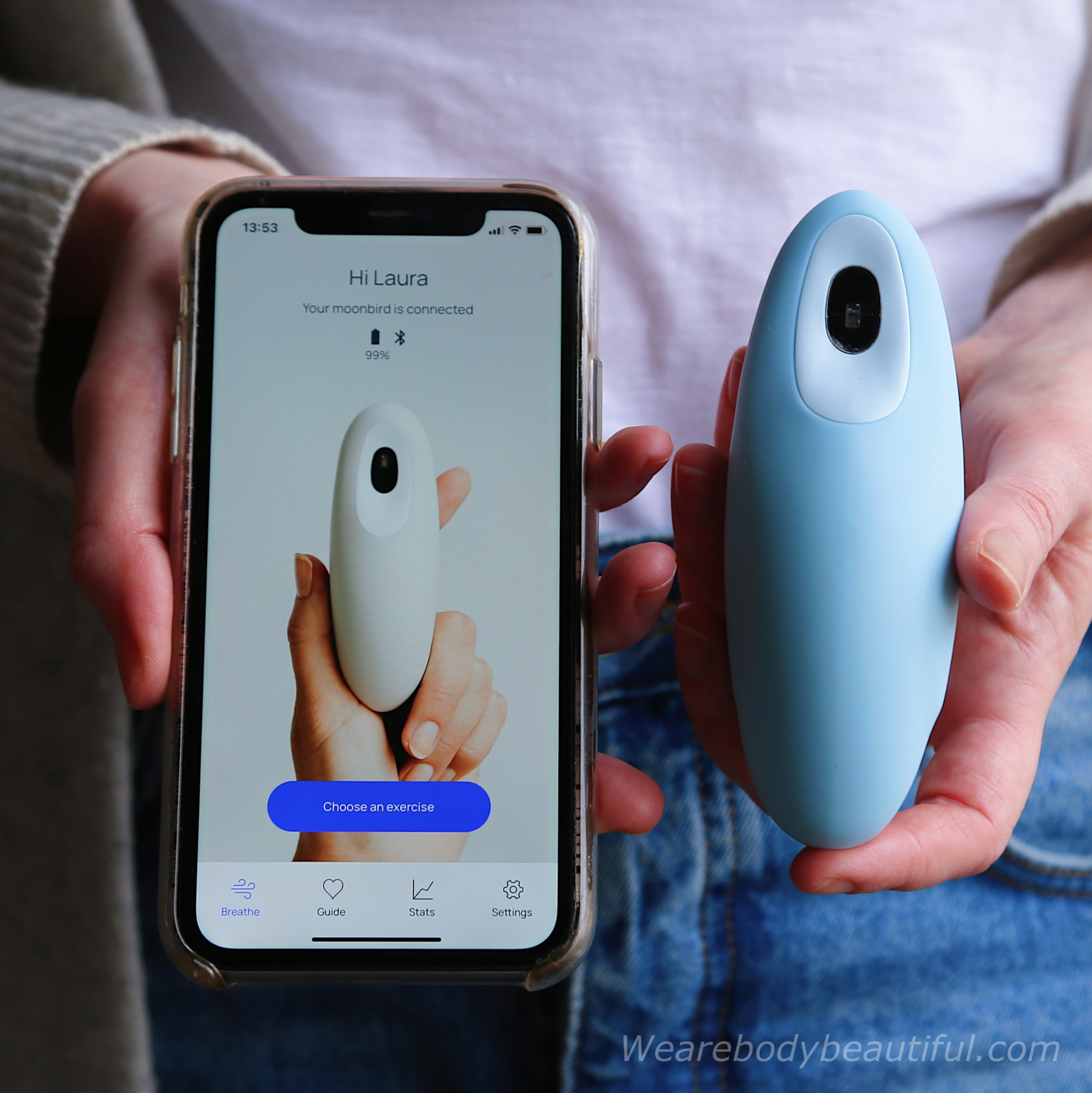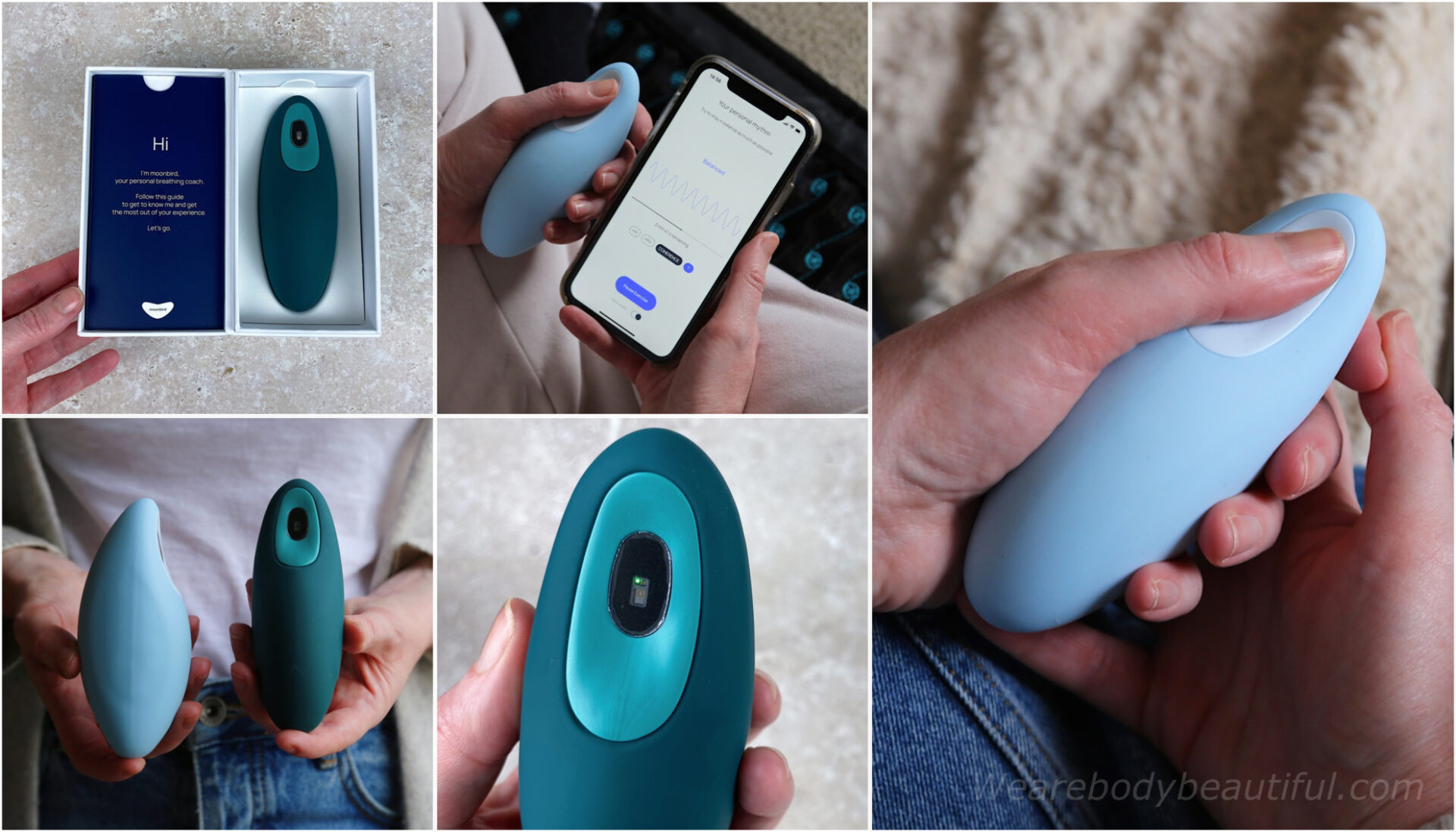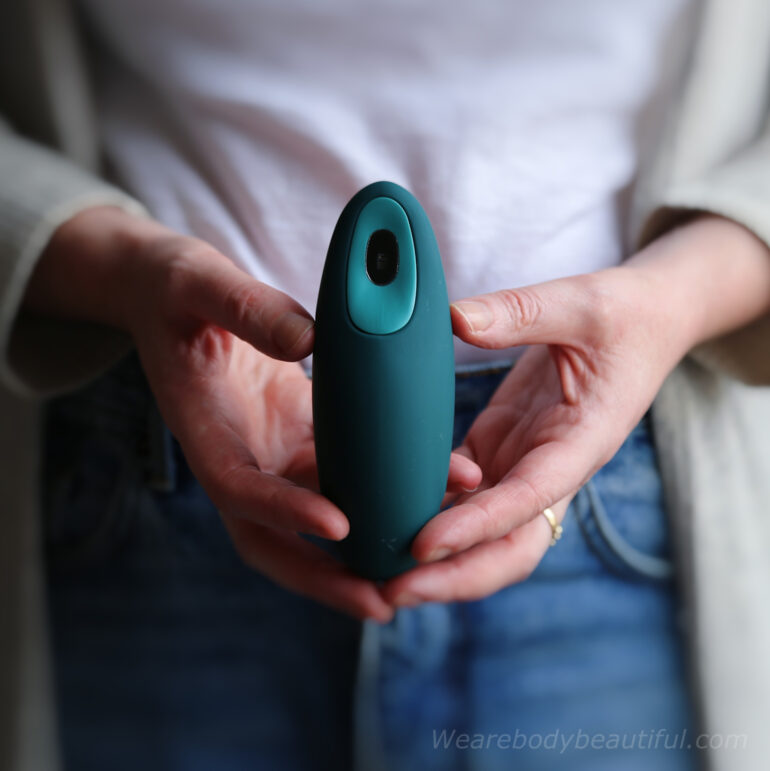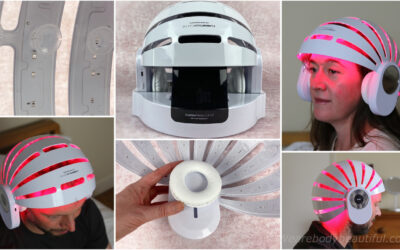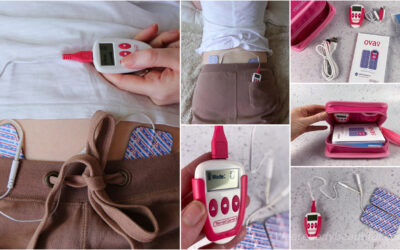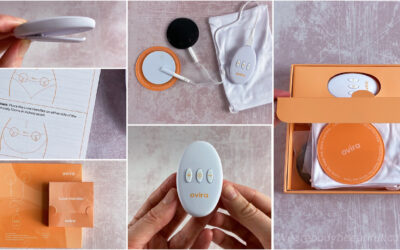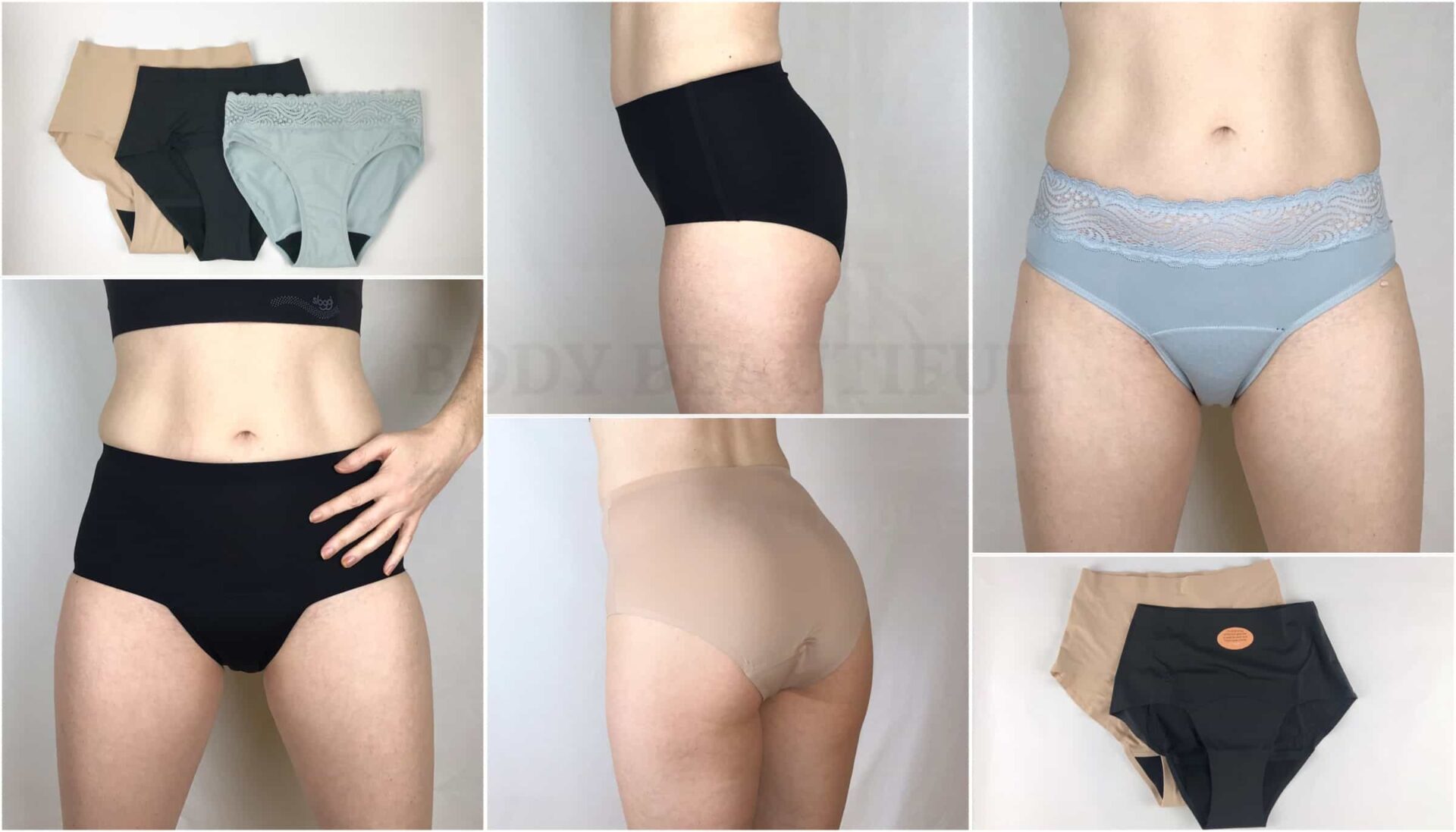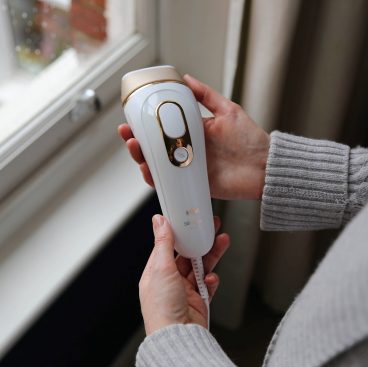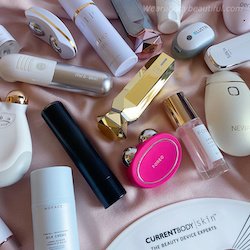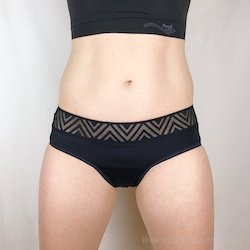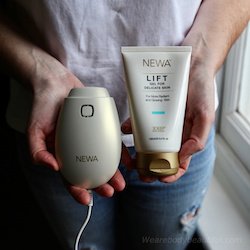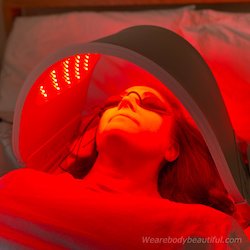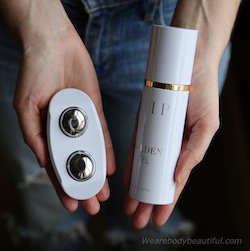What is it?
Moonbird is a handheld deep breathing guide and heart and motion sensor which provides real time biofeedback via the connected app.
You hold the small cordless breathing pacer in your hand and match your breaths to its slow pace – in and out, in and out. Choose from 6 scientifically proven slow breathing exercises. The thumb sensor sends your bio-data to the connected app, where you can track the calming effects on your body.
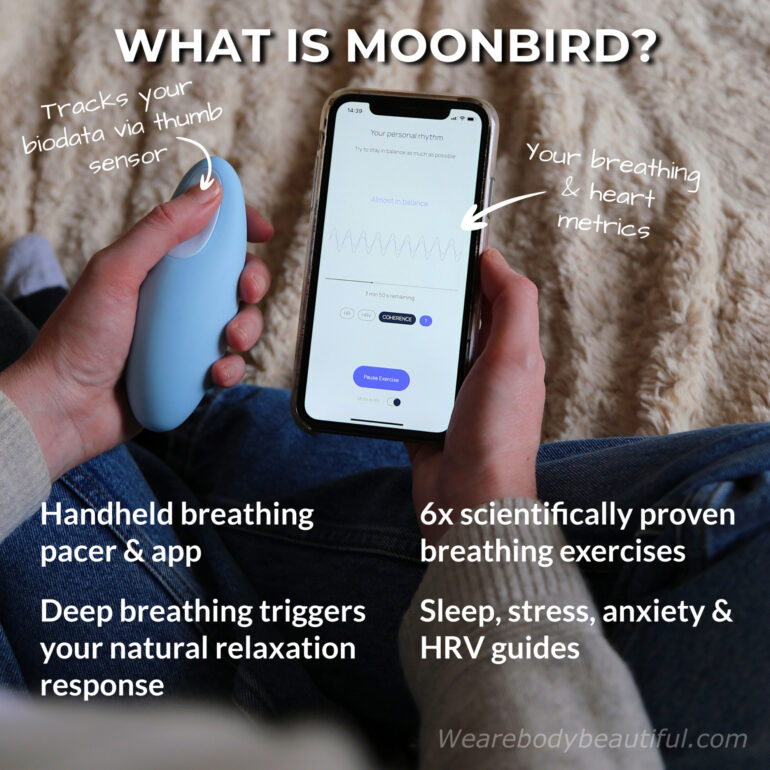
The exercises are at different rhythms to focus on feeling balanced, to fall asleep, calm stress, and curb anxiety. You can also manually set your own personal rhythm or use the app bio-tracking function.
How does it work?
Extensive scientific studies show slow and deep breathing switches on our natural relaxation response. This calms, relaxes, lowers stress and anxiety, and helps you get better sleep.
This is how deep breathing works…
When we see danger, feel threatened or out of control, our ‘fight or flight’ stress response kicks in. Our blood pressure rises, we release adrenaline, our heart beats faster, and we take fast, short and shallow breaths. It’s our Sympathetic Nervous System at work with a short-term survival response meant to keep us alive. However, when we can’t dial it down, this stress grows, often creating anxiety, with physical and mental manifestations we find hard to control.
The opposite is true of the ‘rest and digest’ response, which our Parasympathetic Nervous System controls. This is when we feel safe and relaxed, eating, socialising or sleeping. If we can power up this response, it switches our stress response off, gives us back our control, and a much needed reset.
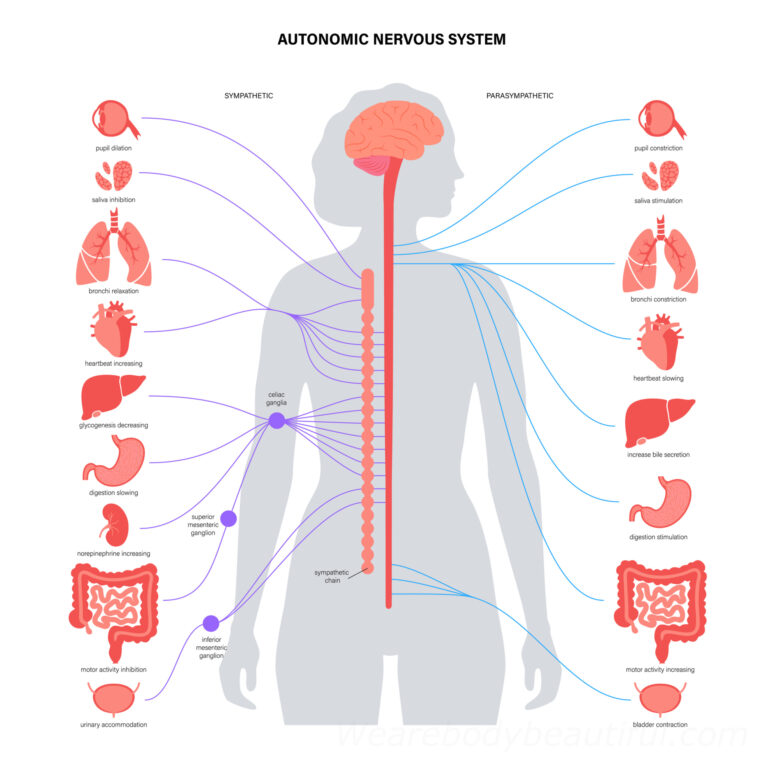
And yup, this is what simple deep breathing exercises do for us. One study shows that as little as 5 minutes of focusing on breathwork stimulates the Parasympathetic Nervous System, which causes a cascade of restorative physiological changes inducing deep relaxation, regulating your blood pressure, heart rate, and cortisol levels.
And not only that, the mind-body connection from deep breathing gives us stronger mental wellbeing, too. Concentrating on breathwork anchors us to the present moment, therefore interrupting cycles of worry and negativity. This present-moment focus also increases mental clarity and cognitive function.
Scientific studies and research prove regular deep breathing exercises offer a range of health benefits, including:
STUDIES SHOW DEEP BREATHING EXERCISES HELP WITH..
✔️Stress reduction
✔️Reducing anxiety
✔️Enhanced focus & concentration
✔️Pain management
✔️Blood pressure regulation
✔️Improved respiratory function
✔️Heart health
✔️Enhanced wellbeing
✔️Sleep quality
Why do you need a breathing pacer?
But can’t you simply do the breathing exercises by yourself?
Well, yes, of course you can. And maybe you already do. But Moonbird has two distinct benefits.
First, studies show that tactile, touch guided breathing induces deeper relaxation. And an EEG brain activity study with and without Moonbird shows this too. When you breathe and focus on your Moonbird, you have much calmer, more focused brain activity than without it.
And second, studies show that biofeedback from breathing exercises helps to reduce stress even more than without it. Specifically, heart rate variability (HRV) training provides a tangible measure of the effects on your body. (There’s more on HRV later). Moonbird measures and tracks your HRV via the app, giving a real time gauge of your relaxation.
Now, let’s see what Moonbird is like.
First impressions
Moonbird comes in a sturdy, tiny, white cardboard box featuring a beautifully manicured hand presenting the device. It makes me want to hold mine (and also get a manicure). It’s friendly, thoughtful and professional, with concise and helpful information to explain what it’s all about. I like the striking blue metallic Moonbird logo, too.
You can choose your Moonbird in blue green, sky blue, soft white, or black grey. It’s a very calming colour palette.
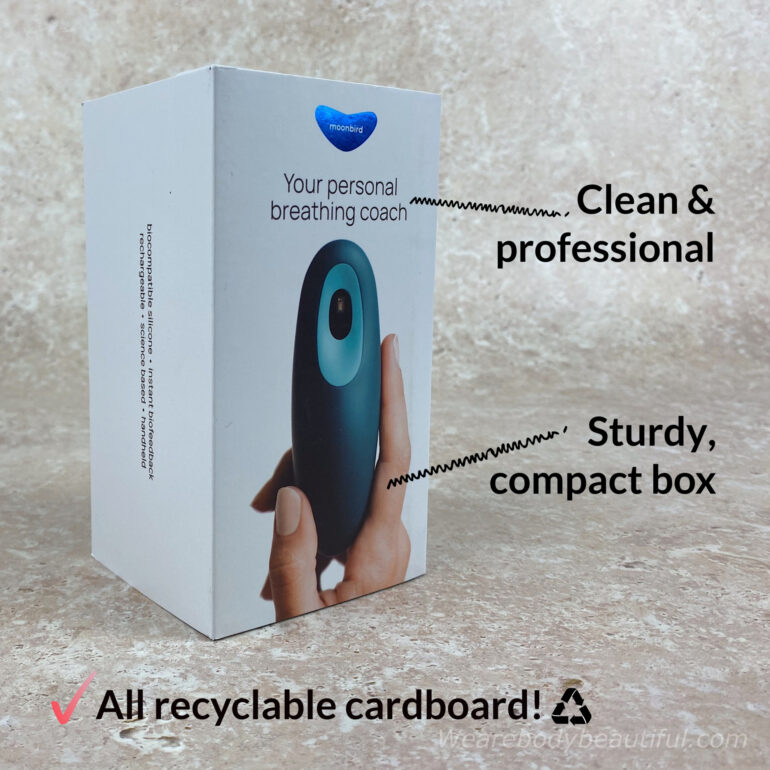
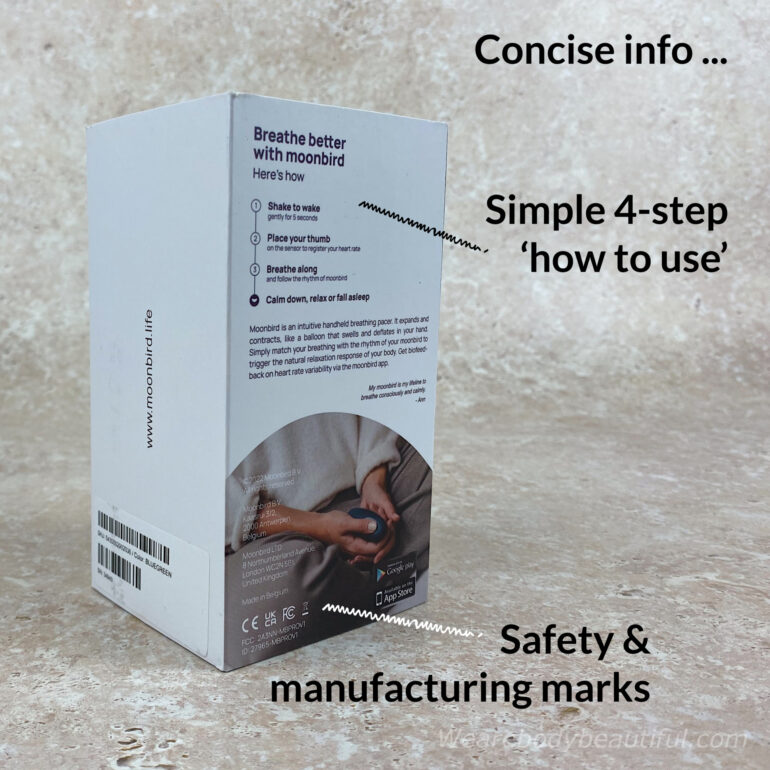
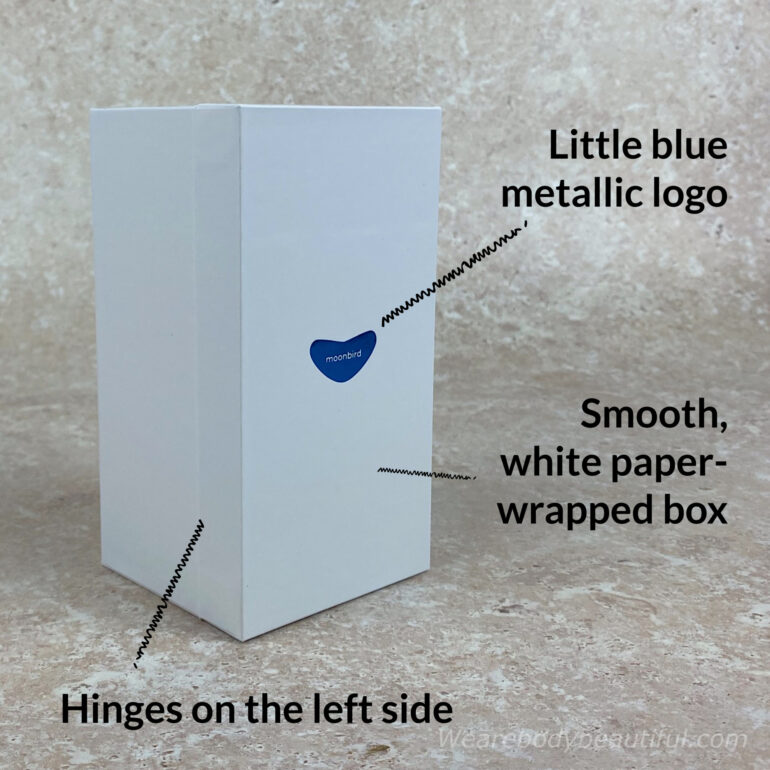
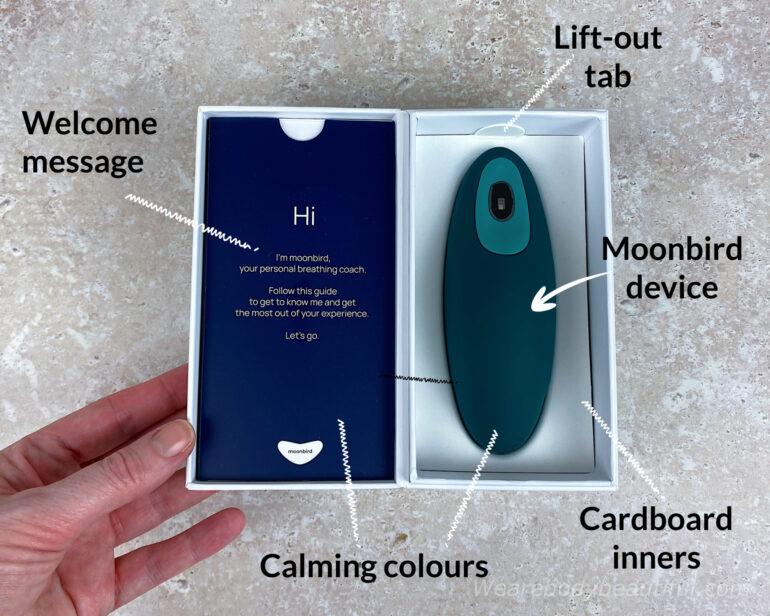
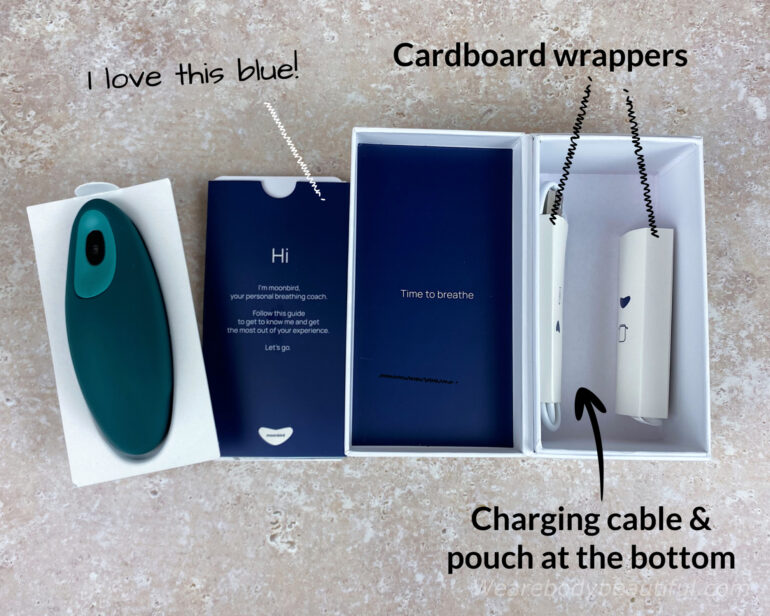
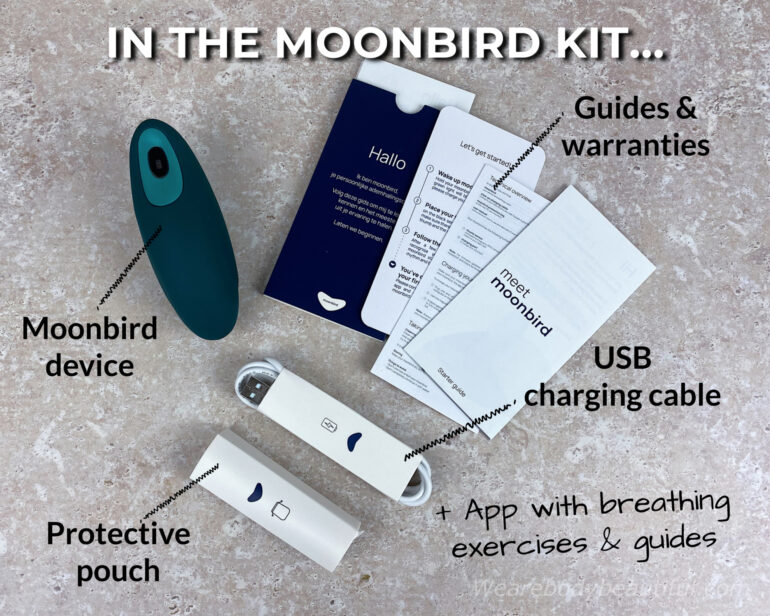
In the Moonbird kit:
- Moonbird device
- USB charging cable
- Protective pouch
- User guide documents
- Moonbird app: download it to access all the breathing exercises, audio guides and articles
Quality & design
The Moonbird device is small and curvy, widest around the middle and with rounded points at the top and bottom. You can see and feel the faint outline of little wing-like shapes on both sides. It’s reminiscent of a small owl body with a mono-eye and puffed out chest.
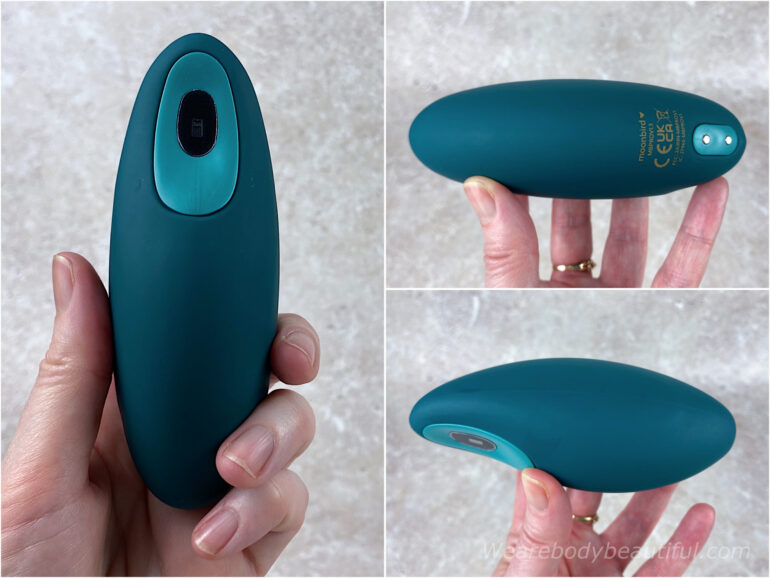
The tactile, grippy silicone feels soft and pleasant to hold. There’s a gently indented thumb rest at the top, edged by a durable solid plastic ring in a slightly lighter shade than the silicone body. And there are two charging contacts on the back.
With no buttons or controls, you gently shake your Moonbird to wake it from their slumber…
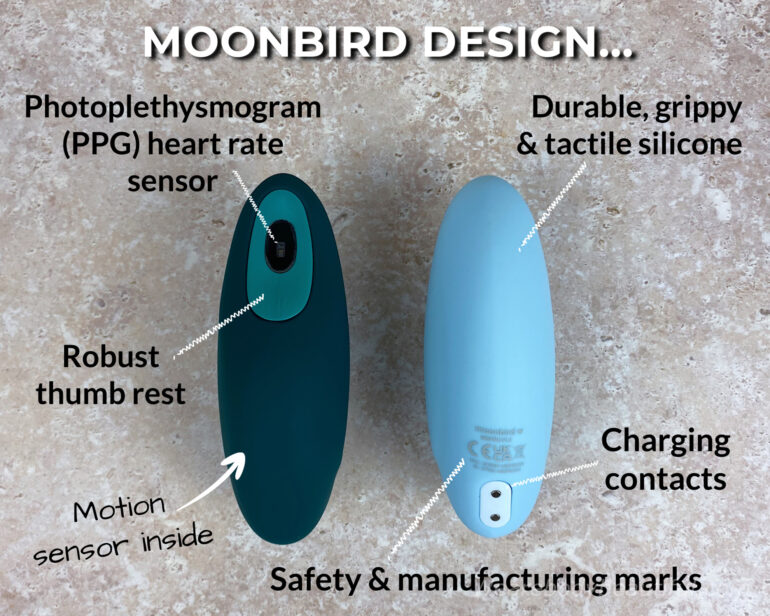
What is Photoplethysmography (PPG)?
Photoplethysmography (PPG) takes measurements in blood flow at the surface of your skin. It uses a light source and a photodetector to measure the volumetric variations of blood circulation in the microvascular bed of tissue, such as your thumb.
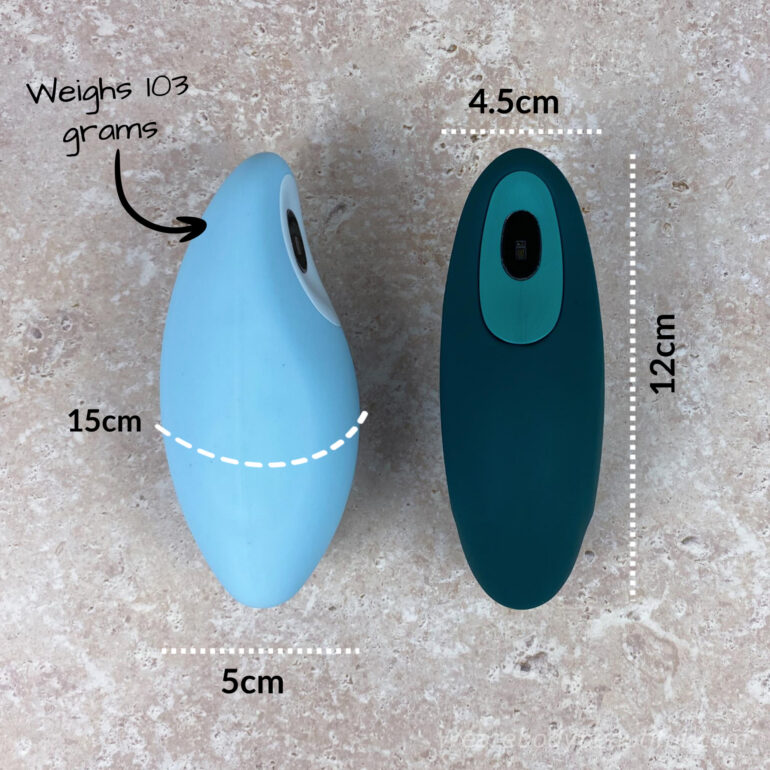
Moonbird fits intuitively in your palm with your thumb on the sensor and your fingers wrapped around the side. The sides slowly and visibly inflate and deflate just like a little bird breathing in the palm of your hand.
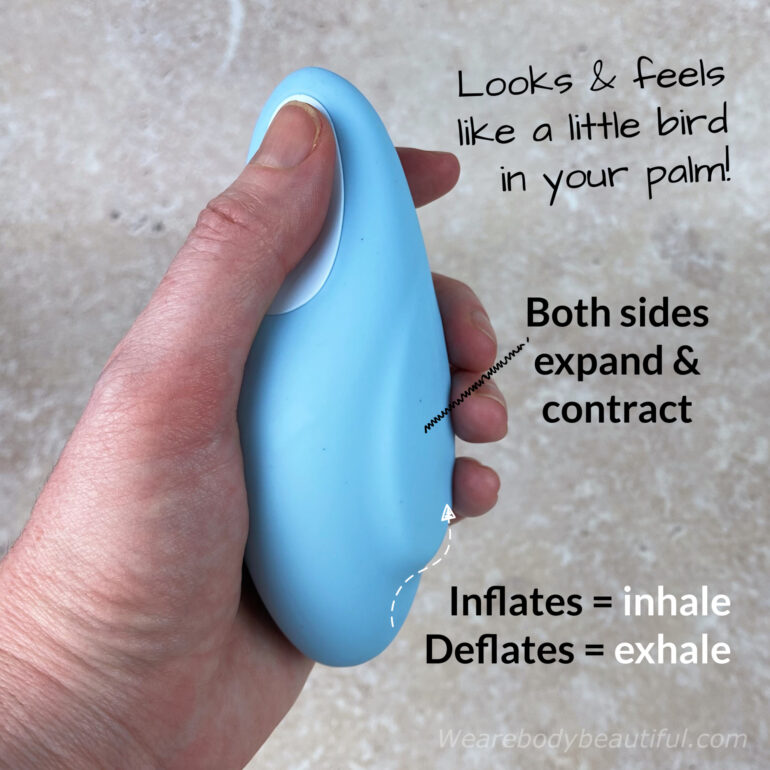
The charging cable connects via magnets to the two charging contacts on Moonbird’s bottom. It’s satisfying how it snaps into place!
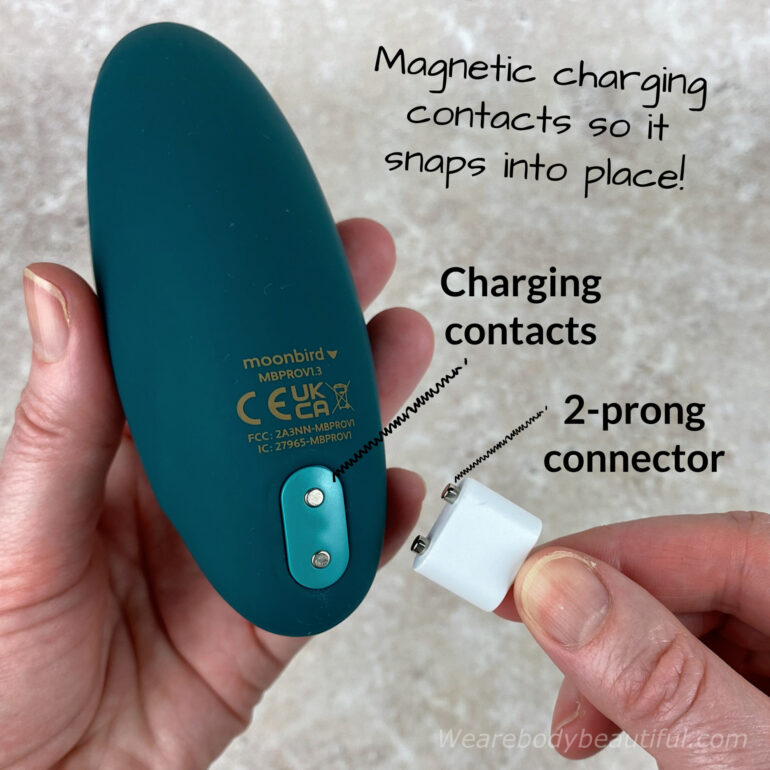
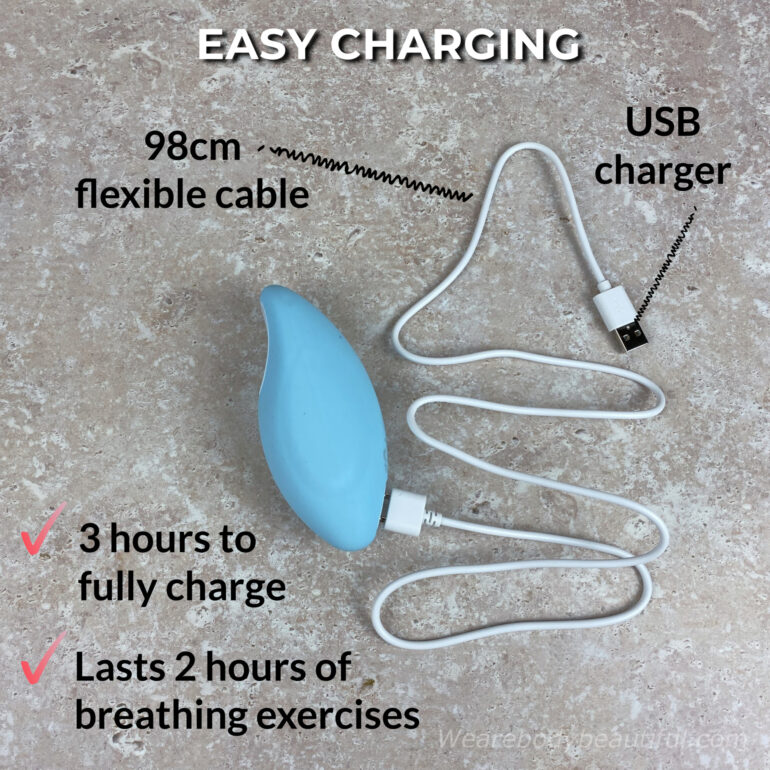
You can check the battery level in the ‘Breathe’ section of the app. The app warns you to charge your Moonbird if you try to start an exercise and don’t have enough battery left.
The Moonbird shape means it can roll around on hard and flat surfaces. Therefore, I like to store and charge my Moonbird inside the protective pouch and box.
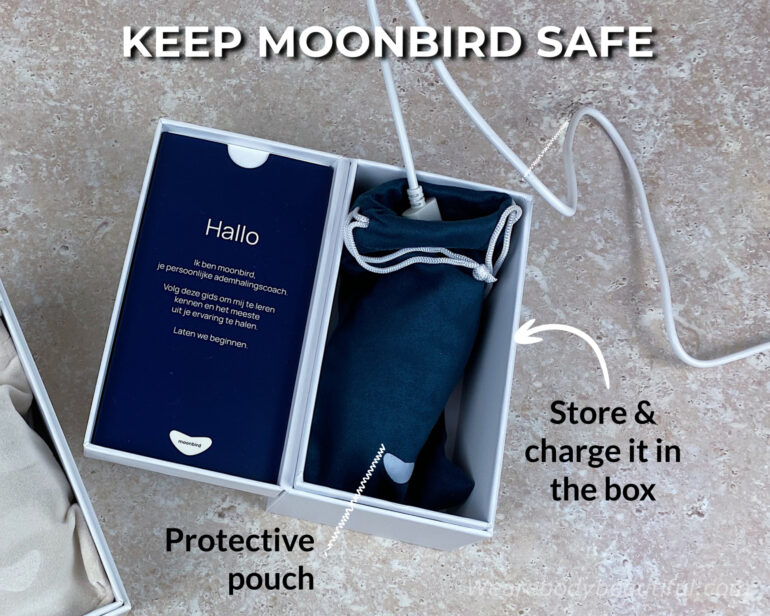
Moonbird app
The app gives access to 6 breathing exercises, each with a different rhythm. You can also listen to educational audio guides as you breathe with your Moonbird, read educational articles, check your stats of previous exercises, and manage various settings such as ‘Travel Mode’ and push notifications.
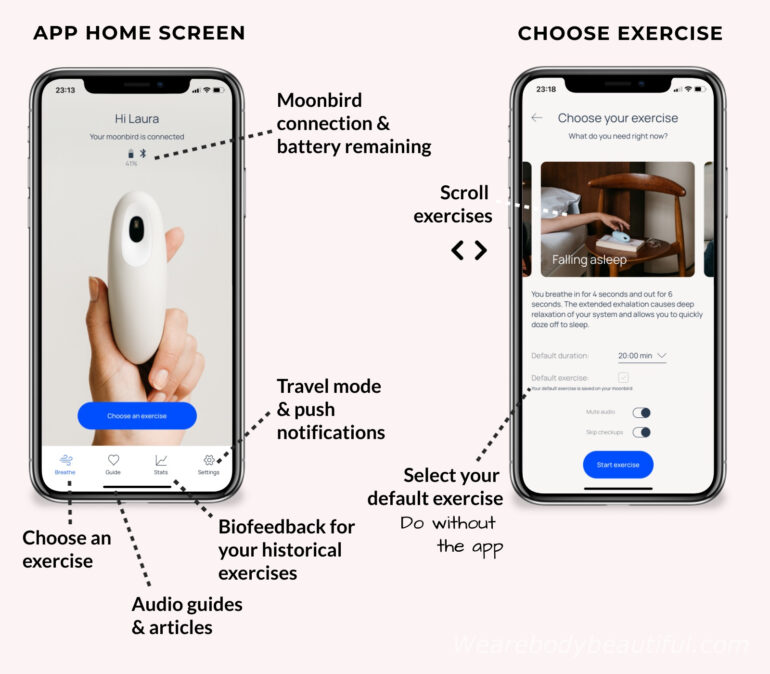
The breathing exercises
You can choose from 4 predetermined breathing exercises. The breathing pace is different for each and focuses on slightly different physiological goals. The rhythms aren’t random. They’re evidenced by various robust scientific studies on breathwork.
At the time of writing, these are the fixed exercises:
- Balanced breathing: Balances your nervous system. 5 seconds inhale, 5 seconds exhale
- Falling asleep: doze off faster & get better sleep. 4 seconds inhale, 6 seconds exhale
- Box breathing: soothes & calms stress. 4 seconds inhale, pause for 4 seconds, 4 seconds exhale, pause for 4 seconds.
- Curb anxiety: Calm your mind & reset. 3.5 seconds inhale, 4.5 seconds exhale
Alternatively, you can manually set your own rhythm. Choose how many seconds for your inhale, inhale pause, and exhale and exhale pause.
And the final exercise option is your personal breathing rhythm, which your Moonbird measures for you when you follow the HRV intake guide. There’s more on that later.
TIP: You can set one exercise as your default and use it without connecting to the app. Just gently shake your Moonbird and you’ll see the light in the sensor window. Place your thumb over the sensor and after a few seconds, your Moonbird starts the breathing exercise. However, the app won’t record your biofeedback when used this way.
The audio guides & articles
The guide section in the app provides a wealth of interesting information presented in different ways to suit different learning styles.
Choose from written, concise articles answering specific usage questions, sharing study results on panic and sleep, or longer and more holistic guides about the power of deep breathing.
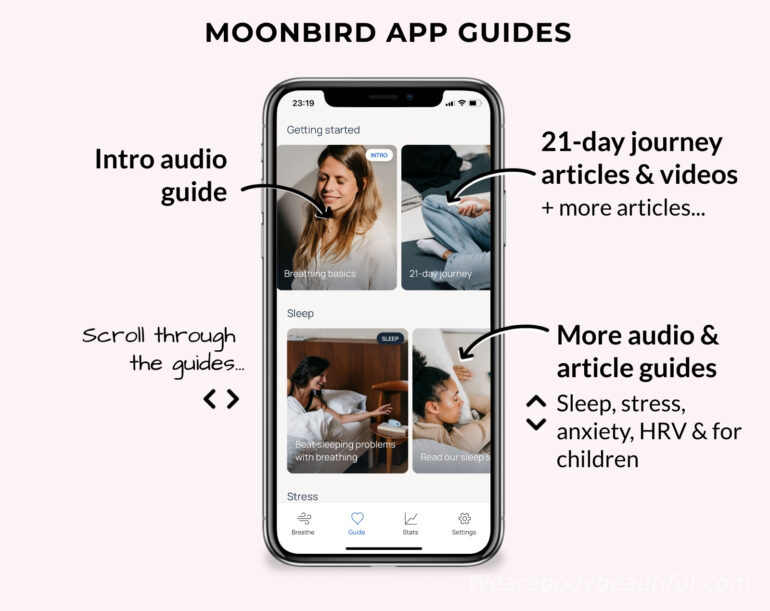
The calming audio guides are a super accompaniment as you practise your daily breathing. Each episode ranges from around 9 to 13 minutes, and there are several to a topic. You can choose to learn about breathing basics, HRV, or how breathing exercises help with sleep problems, stress, anxiety and for children, too.
If you prefer silent breathing practise, you could instead follow the ‘21-day journey’ which has a daily dose of videos and articles, with a suggestion on what to do each day during your first few weeks of practise.
The biofeedback measures
When you connect your Moonbird and app and choose a breathing exercise via the app, your Moonbird measures your heart rate and breathing movements and sends this data back to the app. The app then processes it in real time and presents it back as 3 biofeedback graphs and also records it for future reference.
The 3 biosignal measurements are:
- HR: your Heart Rate in beats per minute (BPM)
Your BPM goes up when you inhale and down when you exhale. - HRV: your Heart Rate Variance as a number
A higher number is best & practice gives improvement. - Coherence: colour coded BPM graph
Shows how much your breathing and heart rate are in sync.
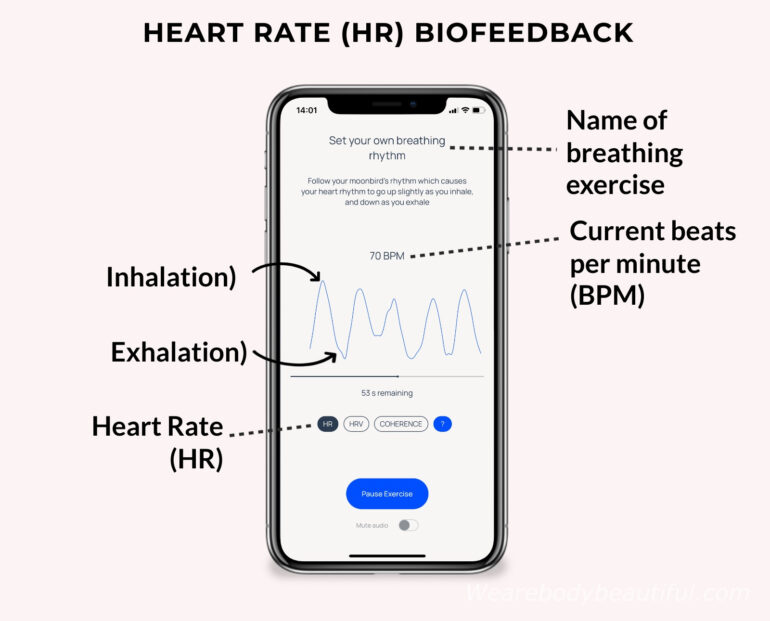
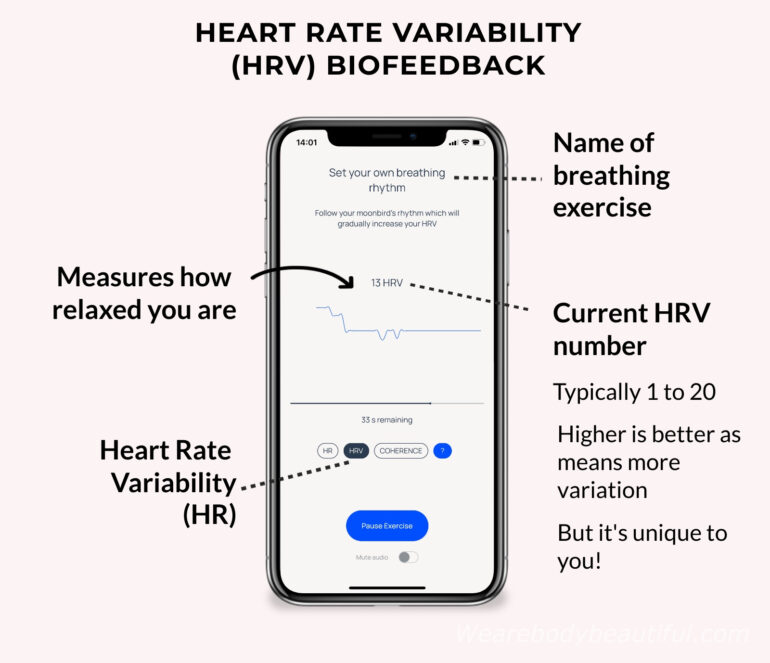
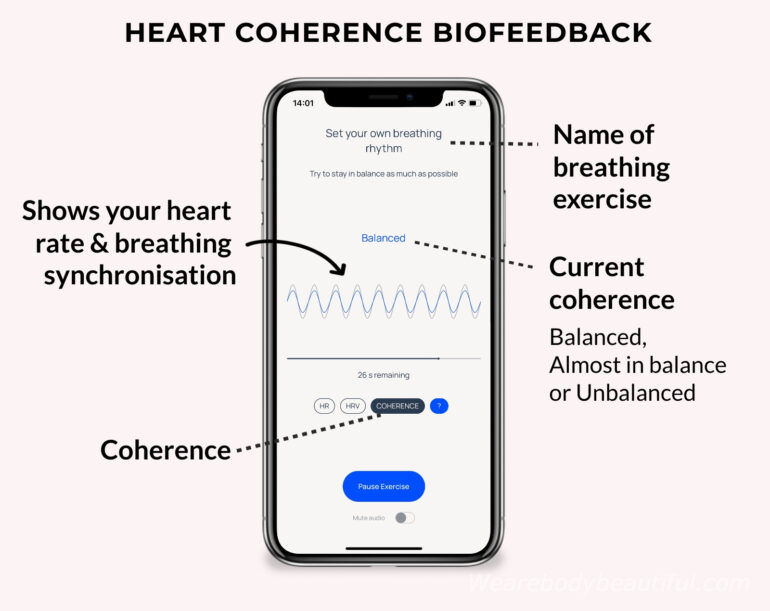
More about HRV…
We all have an irregular heartbeat. One of the key reasons is down to our nervous system. The Sympathetic Nervous System (fight or flight) increases our heart rate, and the Parasympathetic Nervous System (rest and digest) decreases our heart rate.
The variation in the time between beats is called Heart Rate Variation (HRV) and it’s a measure that shows how stressed we are. If our Sympathetic Nervous System is most in control, it increases blood pressure, makes our hearts beat faster and there’s less variation between heart beats. This lower HRV number points towards a stressed state.
If the Parasympathetic Nervous System kicks in, our blood pressure drops, our breathing and heart rate slows, and there’s more variation between each heartbeat. Therefore, a higher HRV number means a more active Parasympathetic Nervous System, and so we’re more relaxed. It also means we’re better able to deal with and recover when we do find ourselves stressed. So, tracking our HRV and training it to improve is an excellent, tangible measure of how deep breathing exercises help us relax and deal with stress.
TIP: Everyone has a different resting HRV number, typically somewhere between 0 to 20. So, don’t compare yours to someone else’s and worry that yours is wrong. Instead, compare where you start with your Moonbird, and look for progress over time, i.e. an increasing HRV number.
Before you start
You get a Starter Guide, Technical Overview and Quick Start leaflet with your Moonbird.
I like you can immediately try out your Moonbird (without connecting to the app) by following the instructions in the Quick Start leaflet.
However, I recommend you read the Starter Guide after you’ve tried it out. It’s a quick, logical and easy read, and it explains the different functions, features and biofeedback metrics, and how to use it with and without the app.
There aren’t any contraindications or risks associated with breathing exercises. However, it’s possible to induce hyperventilation if you don’t do the breathing exercises properly. So, if you feel unwell or lightheaded at any point, simply switch to your normal breathing pace.
And there is a proper breathing technique to follow. This involves breathing through your nose as much as possible, and breathing with your belly. The app audio guides do an excellent job of explaining all this and more. Choose the ‘Breathing basics’ audio guide and the ‘21-day journey’ to get started.
You must also download the Moonbird app to your phone or tablet, create an account, and then connect to your Moonbird. It’s quick and easy. Follow the simple instructions in the Starter Guide leaflet, or the instructions in the app.
How to do a Moonbird breathing exercise
Find a comfy, relaxed spot. You can sit on the floor, on a chair or sofa, or sit or lie on your bed. Whatever works for you.
Open the app, and gently shake your Moonbird to wake it. After a few seconds, they connect and you’ll see the ‘Choose exercise’ button. Tap it to select a breathing exercise and set the duration. Toggle the audio on/off as you like. Tap ‘Start exercise’ to go to the progress and biosignal monitoring screen.
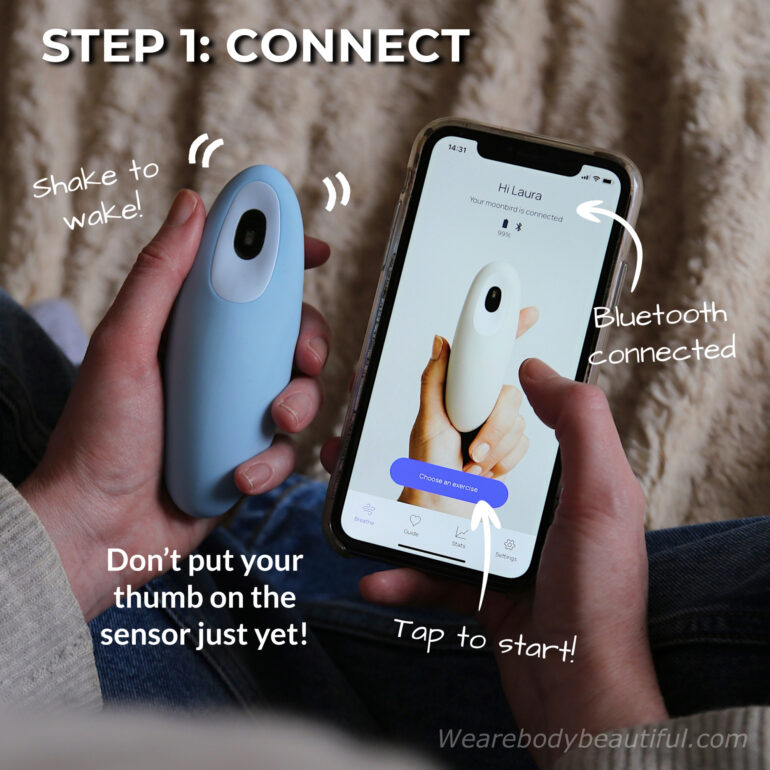
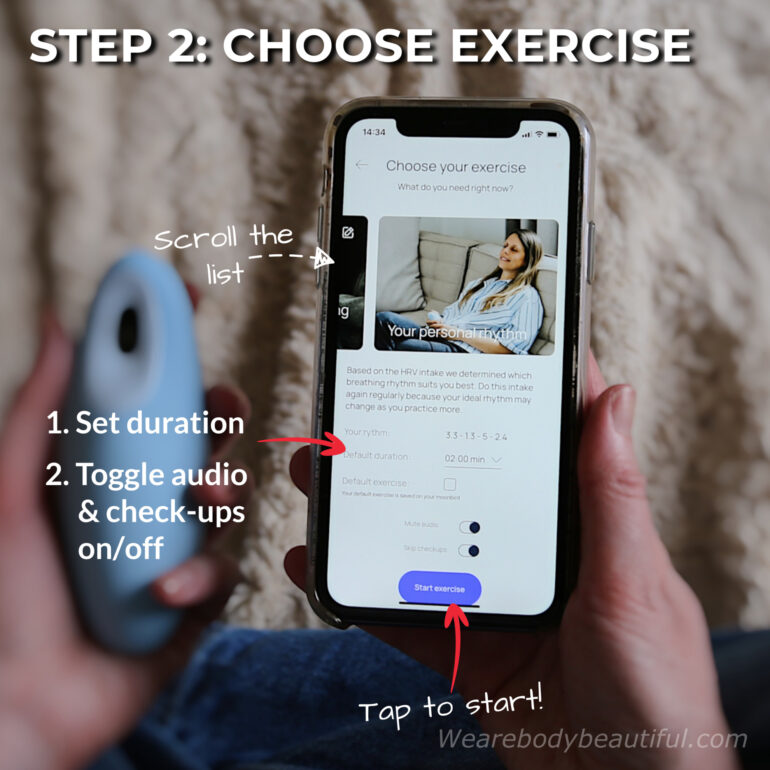
Here, you can choose which biosignal to watch as you breathe, see the time remaining, and turn the audio on/off throughout the exercise. Hold your Moonbird in your non-dominant hand and place your thumb over the sensor. Tap ‘start exercise’ to begin…
It takes a few seconds for the sensor to read your biosignals. You’ll then see them in real time, presented in moving graphs on the screen. The Moonbird also gently inflates and deflates in your palm. Match your breaths to this pace. Breath in when it expands, and out when it contracts.
TIP: I prefer to put down my phone, close my eyes, and concentrate on my breath when my Moonbird starts. I find it more relaxing. But for some people, seeing the real time biofeedback helps them focus more on the breathing exercise. There’s no right or wrong way. You do what feels best.
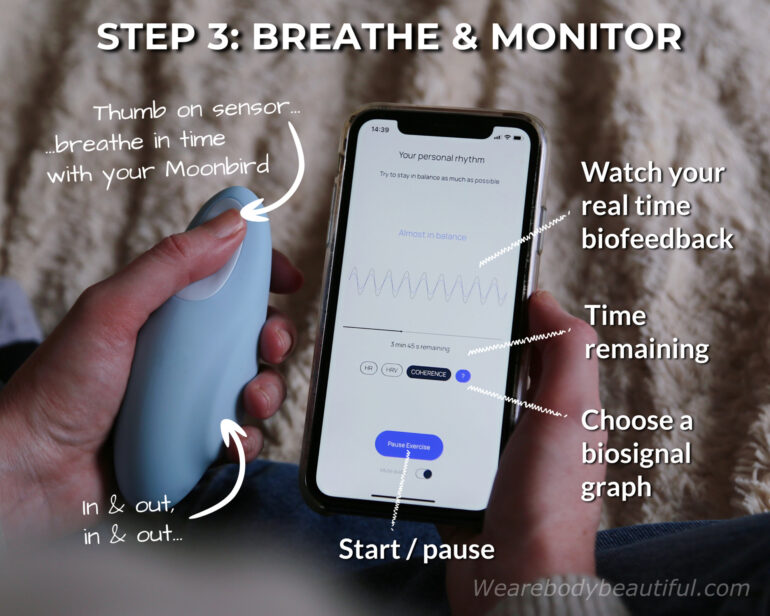
When time’s up, your Moonbird stops breathing and you’ll see the ‘Exercise finished’ message in the app. You can take a few minutes to review your biofeedback for this exercise now, or tap ‘Done’ and save the data in the ‘Stats’ section for future reference.
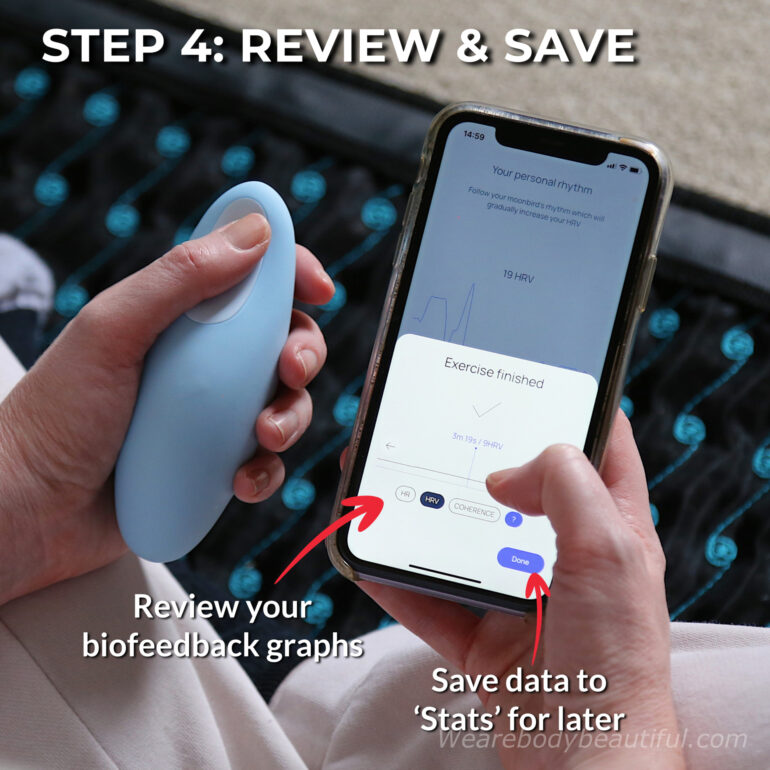
CHECK MOONBIRD BATTERY!
Be sure to check your Moonbird’s battery level on the app home screen at the end of each session. Charge it if your Moonbird is less than 15% so it’s ready to go and complete next time!
You can also use your Moonbird without connecting to the app. Simply choose you favourite breathing exercise from the app and set it as your default. I have ‘Falling asleep’ set as mine. Then, when you’re ready, just shake your Monnbird for a few seconds and place your thumb on the sensor. Your Moonbird starts breathing along to your default exercise.
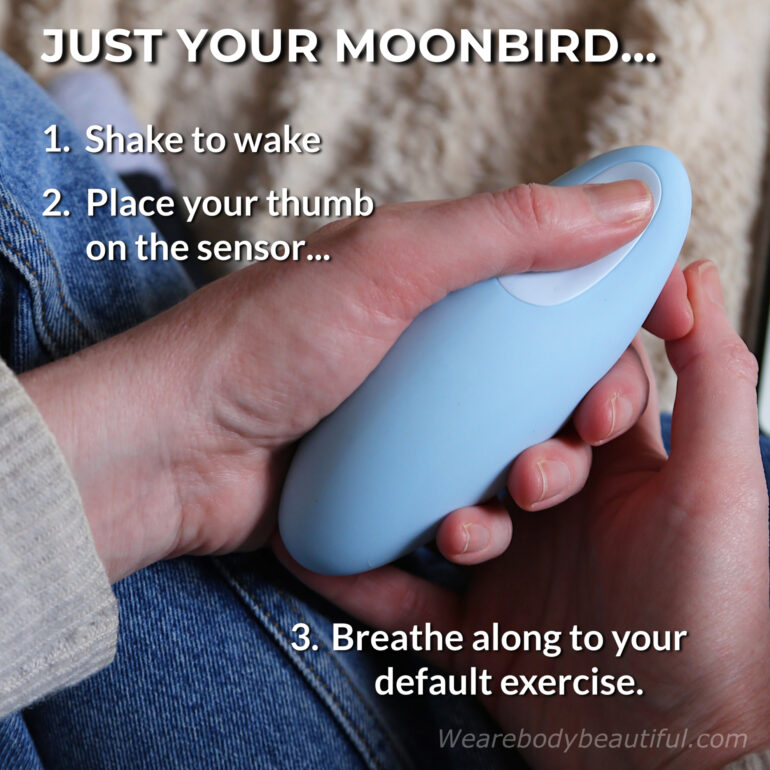
When to use it
To feel the benefits from your Moonbird, use it 2 or 3 times per day. You can start with short practice sessions to get used to it, say, 3 minutes a time. But build up to at least 5 to 10 minutes of breathwork per session. And if you use it at bedtime to improve your sleep, 20 minutes of deep breathing is the sweet spot.
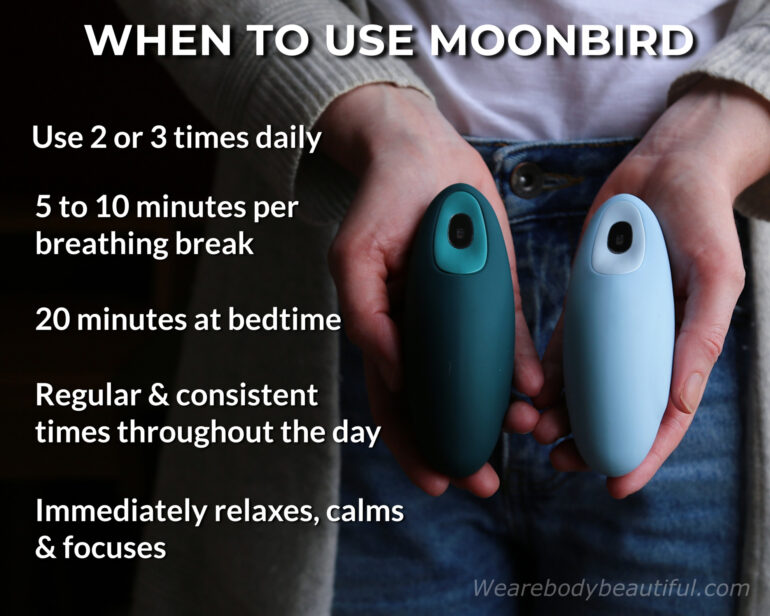
Regularity throughout the day gives the greatest benefits. It keeps your mind calm and focused and improves your physical and emotional wellbeing. And consistency with when you do it means you’ll remember to breathe, and it becomes a habit that sticks.
So, although you can use your Moonbird at any time of the day, the obvious times are those already punctuated by your daily routine. For example, first thing when you get up, a quiet spot at lunchtime, a wind down ritual at home after work, and at bedtime to help you relax, drop off quicker, and have better quality sleep.
START YOUR DAY RIGHT…
Moonbird recommends the best time to practise is early morning before breakfast. That’s because sleep recharges your body and mind, and so it’s easier to concentrate on your breathing. It’s also the perfect, positive way to start your day for less stress and more focus.
But you can also take a breathing break with your Moonbird at any time you feel tension or stress, or simply fancy some quiet time.
My thoughts: What is Moonbird like?
In this section, I’ll share my thoughts on the app, the Moonbird device, the exercises and what it feels like.
First up, the app.
What’s the app like?
It’s a clean and logical design, and the breathing exercises are quick to find and connect. I like that the exercise audio and check-ups are optional too. The audio voice is female, slow and soft, with a slight American twang. It’s non-offensive and I find it particularly soothing, but I also like to breathe in silence too.
I skipped the ‘checkups’ function early in my trial. I didn’t see the point. But I’ve since switched them on again because it feels more relevant now.
The ‘Getting started’ guides are the place to begin. I’m impressed by the breadth and depth of information in these guides.
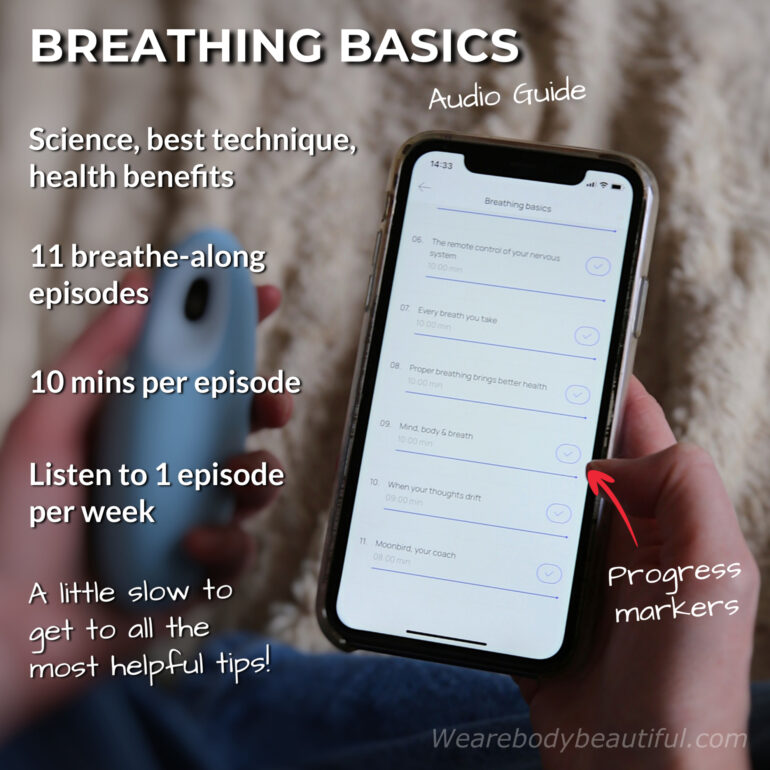
The first guide under ‘Getting started’ is the intro audio guide called ‘Breathing basics’. Moonbird suggests you listen to one episode at the start of each week to educate yourself. Then, during the rest of the week, make the changes they suggest for your daily breathing practice. This, however, means slow progress in listening to all eleven episodes. So, if this is your only guide, it takes weeks to hear all the most helpful tips and explanations.
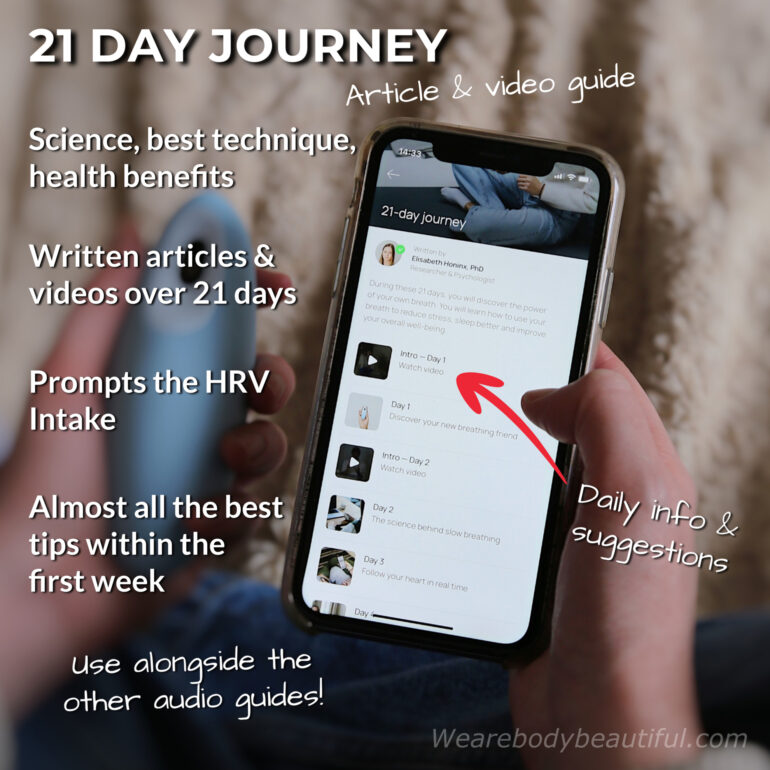
The second guide, called ‘21 day journey’, is my favourite because there’s something to read or watch every day for the first few weeks. I like it most because reading helps me remember more information. Plus, the articles suggest exercises and little changes to try that very day.
You could follow it alongside ‘Breathing basics’ (or any of the specialist audio guides). It’s good if you need daily motivation.
Be sure to check out the remaining four written articles in the ‘Getting started’ section too!
The reminder notification function is also helpful. Once I had a breathing break schedule, I set this for just before lunchtime. That way, if I miss my session after getting up for whatever reason, I’ve no excuse to miss this one!
Next, what it’s like to use the Moonbird pacer device.
What does Moonbird feel like?
I love how Moonbird feels in my hand. The smooth silicone gently grips your skin so your thumb and fingers stay in place even when you deeply relax.
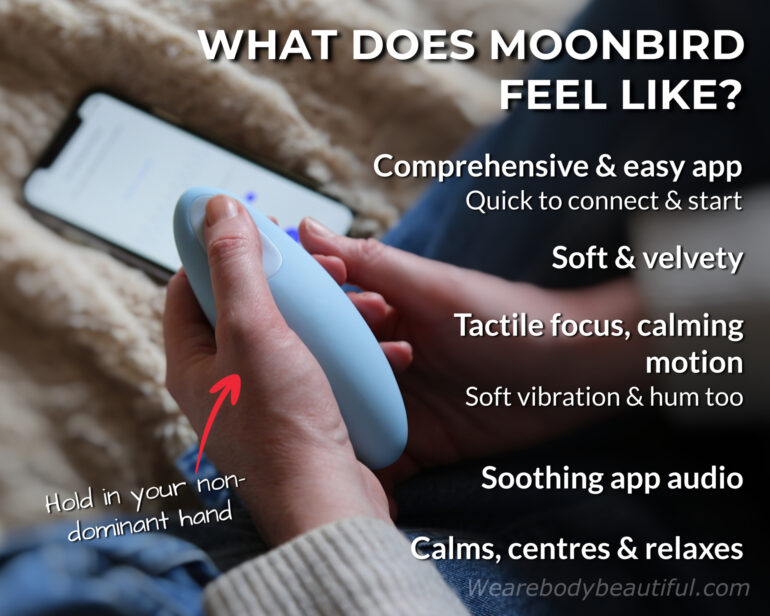
The hold is light and intuitive, but more so I feel, if you have larger hands. I don’t have particularly small lady hands, but I must hold it with my thumb at an angle on the sensor. Otherwise, my fingers don’t reach around to the other side. And it’s much easier to follow the rhythm when you can feel both sides expand and contract in your hand.
You can also feel and hear a subtle hum as the Moonbird breathes in and out. It’s more pronounced as it inflates, pauses, then there’s a lower hum as it gradually deflates. But it’s very soft and not intrusive at all.
Sit or lie down with your Moonbird. I do a bit of both, as the mood takes me. Try all the exercises, with and without audio. My favourites are falling asleep, my personal rhythm (from the HRV intake guide) and a manual rhythm I’ve set recommended from another podcast (4,2,6,2). I find the other breathing exercises too fast, and I easily fall out of sync.
BREATHING EXERCISE TIPS:
- Blow your nose beforehand 🤧
- Wear comfy clothing, nothing that restricts your tummy & chest
- Sit or lie, whatever is best for you
- Make sure you’re warm enough!
- Breathe through your nose
- Breathe into your belly (diaphragm breathing)
- Consciously relax your brow, mouth, neck, shoulders, and down to your toes
- Try all the breathing exercises to find your favourites
- Follow the HRV intake (to get your own personal rhythm)
- Plan your breathing break daily schedule
- Start short (3 mins) and build up to 10+ mins
And it takes consistent practice.
At first I didn’t feel much at all. My thoughts were all over the place and I found it difficult to relax fully. I skipped the check-ups feature because I felt no change in my mood or energy before versus after a session. It seemed pointless. But as you get more consistent and do longer breathing breaks, it starts to feel different.
Now I like to do at least 10 to 20 minutes breathing a time.
I like to close my eyes. It takes a few breaths to settle into the rhythm, breathing slowly through my nose. Once I’ve got that, I then focus on relaxing between my brows, my mouth, jaw and neck. I hold a surprising amount of tension there! Then my shoulders, arms, hands, back, legs, feet and toes. You’ll learn about belly breathing in the guides. This helps you to relax and focus on your breath even more, and it feels good to fill your lungs with no restriction. I like to rest my hand on my tummy to make sure it’s moving up and then down.
After this, about a minute or two in, my body totally relaxes and my mind is much quieter. My thoughts wander a little, and sometimes a lot, but it’s ok. This is where I try to stay for the next 20 minutes. It’s taken a few weeks of practice to get here.
I’ve got a much better breathing technique now. It’s slow and smooth, but precise. My breathing sessions leave me feeling relaxed, with a calm and centred mind. This gives me focus and mental clarity during the day, and helps me to fall asleep faster at night. I’m enjoying this. It fits into my day and I will stick with it.
My trial & results
In this section, I’ll share my personal experience and results using Moonbird over almost 3 months.
Why Moonbird appeals to me?
I don’t have a lot of stress in my life (although I did in a previous career). I don’t have anxiety or worry. So, it’s not these things that pique my interest about Moonbird.
I’m keen for preventative health reasons (I have high blood pressure), and I sometimes struggle with focus. I’m also a night owl and I work from home. As a result, my hours are not typical, with everything starting and ending a few hours late. I struggle to keep my work separate and regularly relapse into very unsociable hours. My sleep schedule is erratic, and I take hours to fall asleep.
I therefore like the idea of breathing exercises because of the positive links to better heart and lung health. And that Moonbird can give me more focus when I need it, or help me switch off and separate from my work. But my chief interest is it can help me fall asleep faster and get better quality sleep so I can stick to a sensible sleep schedule.
Here’s how it went.
The false start…
I began with a 5-minute midday breathing break and 10-minute pre-bedtime session.
Each session left me feeling relaxed. But unfortunately, after a month of trying, I gave up on the ‘better sleep’ goal. You see, there’s more at play here…
As well as my terrible sleep schedule, and the hours I take to fall asleep, I have poor sleep hygiene (such as watching TV in bed). Added to that, is a recently moved in partner with tremendous snoring capabilities.
So, no surprise when I try to correct my sleep schedule, I fail miserably. That’s because my partner falls asleep lightening quick, and then begins his chorus. So, any relaxation I feel from breathing with my Moonbird instantly disappears and I’m stressed within seconds. I then lie awake most of the night, or retreat downstairs to work at my desk until it gets light outside.
So, it’s not fair to test my Moonbird for better sleep. At least, not until I significantly improve my sleep habits and environment.
I’m starting afresh with Moonbird to see what else it can do for me…
Off we go…again
As mentioned earlier, I don’t feel I need to reduce stress or anxiety, so I’m curious what other benefits Moonbird will deliver as I concentrate use throughout my day.
So, I’m now following the ‘21 day journey’ guide. And this makes more sense to me.
This guide has crucial tips (such as holding the Moonbird in your non-dominant hand) right at the very start. And I prefer reading articles in bite-size chunks because I understand and keep more of the information. I like the structure of this guide and look forward to tomorrow’s instalment. It’s also handy there’s a suggested exercise for each day. It’s one less decision for me to make!
I’ve also read the last four ‘Getting started’ articles. They explain how many sessions to do, the ideal breathing rate, session duration, and when to practise your breathing exercises. I’d missed these earlier and I think they’re vital to set you off on the right track.
Now, armed with this new information, I’ve set out a daily breathing break schedule. The first is when I get up in the morning, another before lunch, then after work, and finally before bed. I aim for at least two of these breathing breaks daily.
I’ve also completed the ‘HRV intake’ guide as prompted on day 4 of the ‘21 day journey’. For me, this expertly explains what the breathing exercises are doing. I now understand each of my biosignals during the exercises. The app measures your own personal rhythm breathing rate too. Mine feels notably more natural and comfortable than most of the other app exercises. It’s now one of my favourites.
So, with exercises that feel more like me, knowing which biosignals to monitor, and with a daily schedule to stick with, I’ve now finished just over a month with Moonbird.
My results
The first thing to say is breathing with Moonbird has helped me stick to a daily routine that I desperately lacked. It helps me punctuate my day and take much needed work breaks.
Working from home means I had little structure to my day and I would often sit working at my desk for hours at a time. But planning consistent breathing breaks at key points during the day now means I also eat lunch, I pick a time to stop working, and I’m more likely to go to sleep at the same time each night.
And I’m surprised by how easy it was.
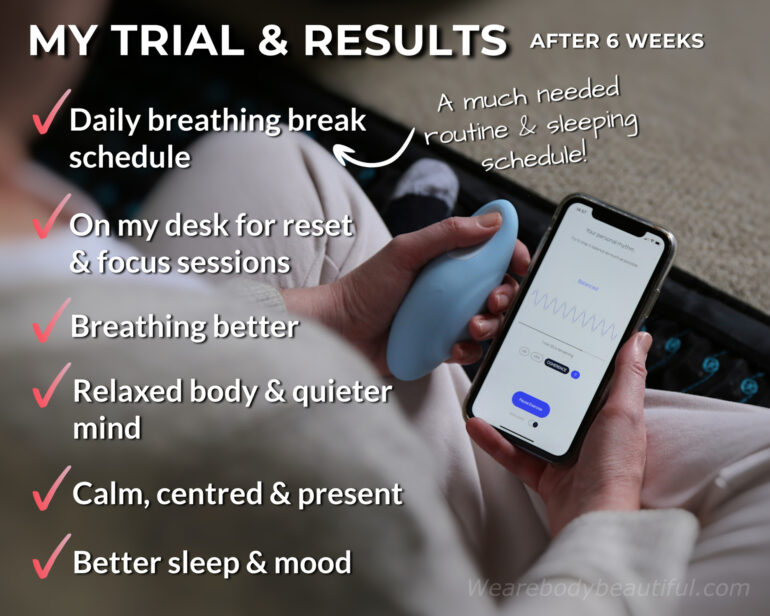
I find my morning session the hardest to remember. But I most look forward to my post-work breathing session, and bedtime breathing is the easiest to remember of all.
I keep my Moonbird next to me throughout the day so I can see it. This means I can also sneak in an occasional extra 10-minute break if I’m struggling with some work or have writer’s block. I find it helps me reset and refocus on the problem at hand.
And I’m finally making progress with my sleep. I have far better sleep habits now. And not only has Moonbird provided a tangible focus on which to better structure my day, but the resulting routine means I now have a sleep schedule I’m sticking to. I’m tired when I go to bed (I never used to be) and breathing for 20 minutes with Moonbird at bedtime helps me switch off and fall asleep much faster.
My sleep hygiene improvements
I’ve made several small and easy daily changes to build better sleep hygiene after listening to Dr Micheal Mosley’s ‘Sleep Well’ podcast series on BBC Sounds. It’s well worth a listen if you find yourself in a similar place to me.
✔️ Go to sleep and get up at a consistent time
✔️ Get outside 🚶♀️🐕💩🌳 within 2 hours of getting up (it resets your internal body clock)
✔️ Bed is for sleep (and sexy times). No TV or phones in bed!
✔️ At bedtime, do 20-mins of ‘Falling asleep’ breathing exercise with Moonbird
✔️ Get up and do something relaxing if you can’t drop off to sleep
Biofeedback results
I like to connect with the app each time I do a breathing exercise so I can track my HRV and my coherence. I made a note of my baseline HRV at the very start. But saw minor change in it during the first few weeks. My coherence was mostly orange (almost in balance) with small sections of green (balanced).
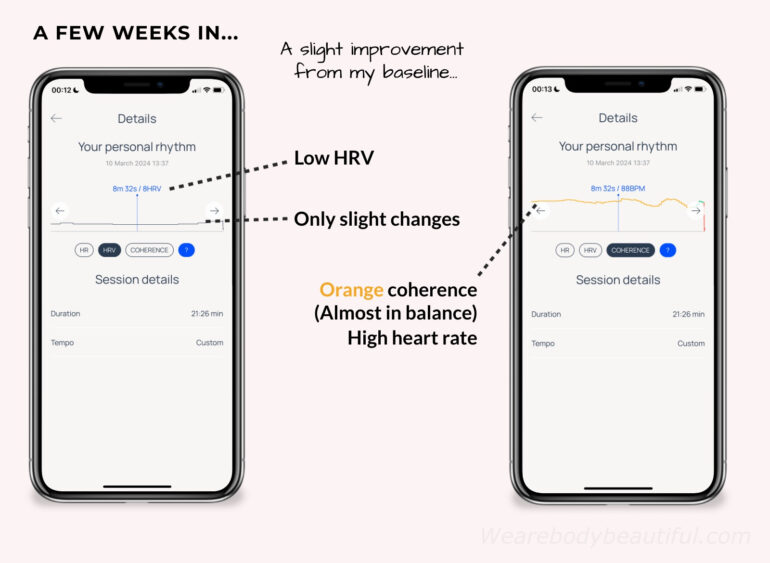
I was a little disheartened.
My expectation was that my HRV number would gradually increase during a session, and over time, too. After a month, I saw higher numbers sometimes, but it still varies during a session and from day to day.
However, more recently, when I review the stats for a session, I see more and more sections of higher HRV and corresponding green sections on the coherence chart. So, I think I am making progress, it’s just not how I expected.
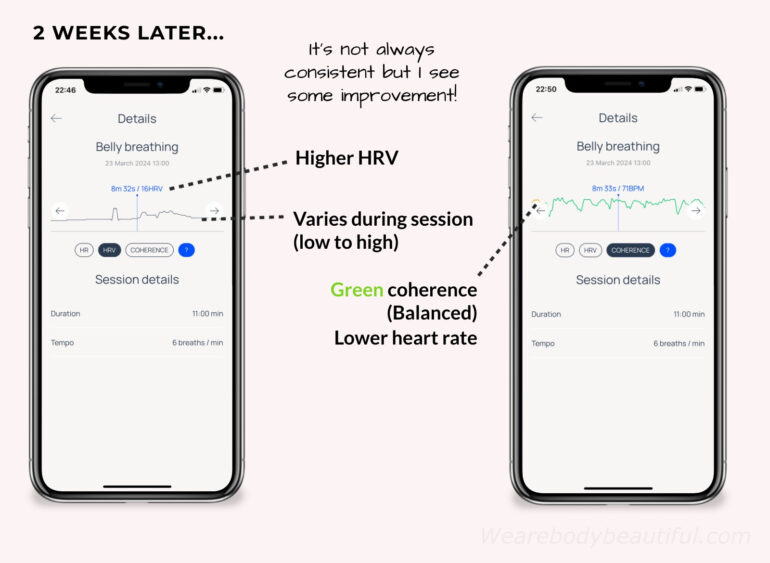
But what is most significant is the growing sense of calm and balance I feel. I feel it during and just after a breathing session, but also in between sessions too. And I’ve noticed my mood is perking up too. It’s much less ‘meh 😐’ and much more ‘yeh 😊’.
The negatives
There’s not much to dislike about Moonbird.
The app is simple with wonderful content and the device is quality is excellent, and it’s easy to charge with a good battery life. The sensation of the Moonbird breathing in your palm is an effective focus to guide your breath, and the biofeedback clearly shows what it does. And with a 30-day money-back guarantee, I think it’s very good value.
As mentioned earlier, you may find the Moonbird device a little large to start with if you have small hands. But it doesn’t take long to find a comfy grip so you can best feel the movements.
Another consideration is, although Moonbird makes it easier to do your breathing exercises, it still takes practise. And it’s up to you to remember to do them and build the habit.
You can start small, with brief sessions, so they’re easier to fit in. But try to commit to at least two a day. Otherwise, you won’t feel like it’s doing very much at all.
Moonbird review summary
I’m a huge fan of taking regular breathing breaks with my Moonbird. That’s because I feel more relaxed, balanced and centred during the day, and sessions help me reset and focus when I need it. I see some improvement in my biofeedback stats, but what I really love is it helps me stick to a daily routine and sleep schedule that I struggled with before. I wouldn’t be without it now.
4.7 / 5
Tactile breathing pacer & app
💰💰
Here’s a quick recap of my test results and pros and cons of Moonbird:
Ease of use
👍👍👍👍👍
This intuitive & calming slow breathing pacer and app combo is very easy to use. With your thumb on the sensor, match your breathing pace as the Moonbird pacer inflates and deflates. It’s curvy and tactile, fits comfy in your hand, and makes focussing your breath effortless. In the simple app, choose 1 of 6 exercises, check your biofeedback progress, and follow the guides to learn the best breathing technique.
Effort
💧💧
Requires consistency & regular use. Do at least 2 breathing breaks per day. Pick consistent times such as breakfast, lunch, evening or bedtime, so it quickly becomes a habit. Start with 2 or 3 mins and build up to 10+ mins sessions, or 20 mins before sleep. Feel results after 21 days. For ongoing use. Discreet, and easy to fit around your daily routine.
Effort & results
⭐⭐⭐⭐⭐
From each session, you’ll have a lower heart rate, blood pressure, cortisol levels, and stress response. You’ll feel deep relaxation and a stronger mind-body connection which reduces stress, anxiety and worry, boosts mental clarity, helps you fall asleep faster and wake-up less often. Practise trains your body and mind to be more relaxed and resilient.
Pros
- Quiet & discreet
- Small, lightweight & tactile
- Good battery life & easy charging
- Scientifically proven breathing rhythms
- Manually set your own rhythm
- Thorough app guides
- Learn through reading, listening & practise
- Use with or without the app
- Fits around your daily work routine
- Instant reset: feel calm, soothed & present
- Greater health & mental benefits overtime
- Handy protective pouch
- 30-day money-back guarantee
Cons
- Takes time to form the habit
- Takes practise & dedication (but very pleasant)
- Maybe a little big for small hands
Buy Moonbird
Found this review helpful? Please support future reviews and shop via these links. I earn a small commission, but your price stays the same.
🛒 Buy from Moonbird
Moonbird.life
Free delivery & 30-day money-back guarantee

